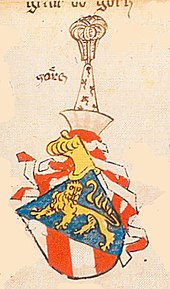Albert I. (Gorizia)
Albert I, Count of Görz and Tirol (* around 1240/41) from the Meinhardiner family was the second son of Count Meinhard III. von Görz and Tirol (I.) and the Adelheid, daughter of Albert III. , the last count from the House of Tyrol. He died at the beginning of / (3rd) September 1304 in Lienz and was buried in the monastery of Rosazzo / Friuli according to the Annales Foroiulienses.

Acting as Prince of Gorizia
When his father died (Jan. 12 - Feb. 18, 1258) Albert I was still held hostage at Hohenwerfen Castle with his older brother Count Meinhard II of Tyrol and Gorizia (IV). The brothers got into this predicament in exchange for their grandfather, Count Albert III. of Tyrol around the turn of the year 1252/53, after the unsuccessful attack by Count Albert III. and her father Meinhard III. from Gorizia to the penal land of the chosen (Archbishop) Philip of Salzburg . In the interim period until his brother Meinhard II von Tirol was released at the beginning of 1259, several documents indicate that his mother Adelheid von Tirol was in charge of administration. Albert I was released in 1261, he first documented it on August 28, 1261 in Aibling. He shares the administration of the territories with his brother: he took over the Görzische Lands , his brother Meinhard II. However the newly acquired county Tyrol. On March 4, 1271, a formal division of the lands took place on this basis, after which Albert I received the possessions of his house in Görzischen , Friuli , Istria , Carniola and Carinthia as well as in the Pustertal east of the Mühlbacher Klause . A number of rights and revenues (e.g. coins, customs duties) should be acquired together and then shared. Like his brother striving to enlarge his territory, he got into a dispute as bailiff with the Patriarch of Aquileia . Albert was ruthless in expanding his sphere of influence. The clashes culminated with the capture of Patriarch Gregory in 1267 and the murder of Bishop Albert von Concordia (1268). Count Albert I was excommunicated by the apostolic legate, also because of the support of the Staufer Konradin . Through the additional interference of King Ottokar II Premysl , Albert's position of power over the patriarchate was weakened. Later, the ongoing expansion of Venice again led to joint action by the patriarchate and Count Albert I. When the war between Ottokar von Böhmen and Rudolf I von Habsburg broke out , he joined the latter, like his brother, and launched an attack in support of the latter on Krain and the Windische Mark (1276).
Albert I was married twice: the first time from 1266 to Euphemia von Glogau, daughter of Duke Conrad II of Silesia-Glogau. The second time from May 1275 with Euphemia, daughter of Count Hermann von Ortenburg. His second wife had already been awarded to him by a marriage agreement in 1256, which did not materialize because of the continued hostage detention. She then married Count Konrad II of Plain and Hardeck, who fell against the Hungarians in June 1260 in the battle of Staatz. Euphemia appears for the last time in a document on February 1, 1304 when King Albrecht I confirmed her marriage certificate . According to the monastery chronicle, she was buried in the cloister of the Dominican Convent of the Visitation of Mary in Lienz. Count Albert I had three children: According to the marriage contract of May 29, 1275, the older son, Heinrich II of Gorizia, comes from the first marriage. Albert II of Gorizia. and a daughter Clara Euphemia are children of the second marriage. From around 1292 Count Albert I left the management largely to his son Heinrich II of Gorizia. Before his death on October 25, 1303, he divided his lands between his sons Heinrich II and Albert II of Gorizia.
literature
- Alfons Huber: Albert II., Count of Gorizia and Tyrol . In: Allgemeine Deutsche Biographie (ADB). Volume 1, Duncker & Humblot, Leipzig 1875, p. 181 f.
- Eduard Widmoser: Albert I .. In: New German Biography (NDB). Volume 1, Duncker & Humblot, Berlin 1953, ISBN 3-428-00182-6 , p. 128 ( digitized version ).
- Wilhelm Baum: The Counts of Görz in the European Politics of the Middle Ages, Klagenfurt 2000.
- Hermann Wiesflecker: The regests of the Counts of Görz and Tirol, Count Palatine in Carinthia, Volume I, Innsbruck 1949.
- Philipp Jedelhauser: The descent of Bishop Bruno von Brixen, Count of Kirchberg (Iller) with an excursus on Countess Mathilde von Andechs, wife of Count Engelbert III. von Görz with family tree of the Counts of Görz, in: Adler, Zeitschrift für Genealogie und Heraldik, Volume 28, Issue 6–7, Vienna, April / September 2016, pp. 277–341. (Also published as a book, ISBN 978-3-00-052489-9 ), (Family table of the Counts of Görz, annotated according to sources).
| predecessor | Office | successor |
|---|---|---|
| Meinhard I. |
Count of Gorizia 1271 (1258) -1304 |
Henry III. |
| personal data | |
|---|---|
| SURNAME | Albert I. |
| ALTERNATIVE NAMES | Albert I., Count of Gorizia and Tyrol |
| BRIEF DESCRIPTION | Count of Gorizia |
| DATE OF BIRTH | around 1240 |
| DATE OF DEATH | before September 7, 1304 |